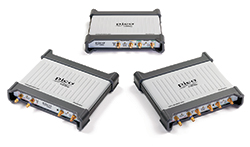
In wide bandwidth test and measurement applications, it is common to use a fast transition pulse as a stimulus to the device under test (DUT). With its broad spectral content, such a pulse can, in a single instant, drive a component, transmission path or system with all the frequencies that it will likely encounter. By gathering the response of the DUT, either from instrumentation within the device itself or using a wideband oscilloscope to capture its output, fast and detailed device characterization can be performed. However, very fast transition pulse generators can be relatively hard to find and can be expensive. The same can be said of broadband oscilloscopes, because the generation, delivery and recapture of pulses with transition times of a few hundred picoseconds or less is quite challenging.
Pico Technology specializes in these technologies, supplying fast pulse generators with transition times down to 40 picoseconds within its 12 and 20 GHz sampling oscilloscopes. With the launch of the PicoSource PG900 USB controlled pulse generators, those technologies are available at a lower cost and in the flexible format of a stand-alone differential pulse source. The products are suited to the characterization of microwave and gigabit devices, lines, networks and systems for signals up to 10 GHz and 20 Gbps. These pulse generators are high speed, low cost instruments for use in single-ended and differential pulsed measurement applications, such as time domain reflectometry (TDR) and radar system, semiconductor, gigabit interconnect and port testing. The generators are typically used to drive broad spectral content into a 50 Ω cable, connector, RF semiconductor or other DUT. The reflected or transmitted pulse can then be monitored and displayed by a broadband or sampling oscilloscope (see Figure 1). TDR or time domain transmission (TDT) analysis are alternatives to vector and scalar network analysis and widely used to speed the development, evaluation and testing of high speed data paths (e.g., Ethernet, USB, HDMI, SATA) and RF, radar and microwave devices, cables, networks and equipment. Figure 1 shows the responses to a pulse applied to a 50 Ω controlled impedance, differential line on a printed circuit board. Channels 3 and 4 (i.e., the purple and green traces) display the launch pulse, and channels 1 and 2 (i.e., blue and yellow traces) show the effects of crosstalk on an adjacent differential line about 3" along the PCB.

Figure 1 PicoSource PG900 high speed pulse output viewed on a PicoScope 9341 4-channel 20 GHz oscilloscope.

Figure 2 PicoSource PG900 software screen used to set pulse parameters. Three timescales are available to display pulses.
PicoSource PG900 generators are compact USB devices that connect to a PC running Microsoft Windows, with the advantages of
- Leading microwave performance in a compact and portable instrument
- High resolution graphical display
- Easy setup via keyboard, mouse or touch screen.
Figure 2 shows the software screen used to set the pulse generator parameters.
DESKEWABLE DIFFERENTIAL OUTPUTS
The pulse generators have deskewable differential outputs adjustable to 1 ps resolution, which allows timing inequalities in test connections and fixtures to be nulled – or the deliberate introduction of timing skew to stress test the system. Each of the outputs can also operate in a single-ended mode. The PG900 Series offers two triggered step-generation technologies to suit different applications. The PG911, with integral step recovery diode outputs, offers a transition time of less than 60 ps with a large and adjustable output swing of 2.5 to 6 V on each output. These pulses can support high dynamic range and long distance measurements, exercising all signal amplitudes in most transmission systems and devices. The PG912 uses external tunnel diode pulse heads to deliver a faster transition time of less than 40 ps with fixed 200 mV amplitude at the interface plane. A third model, the PG914, combines both technologies in one space-saving, economical unit. All models feature low jitter, external trigger input and output and an internal trigger clock with comprehensive width, period and hold-off adjustments. Pulse edge jitter with respect to the trigger input and output is less than 3 ps RMS.
The portability and low cost of the PG900 generators can bring RF and microwave testing out of the lab and into the world of on-site measurement. Typical applications include: TDR/TDT network and match analysis, spectral and flatness measurements and timing, jitter and crosstalk determinations. The PG900 pulse generators can partner the PicoScope 9300 20 GHz sampling oscilloscope in many of these applications.
Pico Technology
St Neots, U.K.
www.picotech.com
